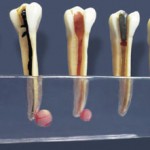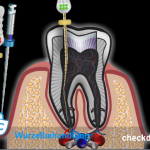Small filling – big filling – root treatment – root tip resection – removing a tooth
 Does this process look familiar to you?
Does this process look familiar to you?
Whether it does or not, we would like to explain why this happens. It may help some of you to avoid this, while others will at least realize that there is no such thing as bad teeth!
1. People rarely ever have bad teeth and if this is genetic, all of a person’s teeth are affected!
Why do you mostly have fillings in your side teeth? Find out here!
2. Good, now we know that your “bad teeth” are at least partly your own “fault”! Unfortunately, dentists only rarely inform their patients about why things like this happen, they usually just keep drilling, while your fillings keep getting bigger and bigger, until one fine day you need a root canal treatment.
The right way to perfom root treatment is … here we have a video for you, but be sure to come back after your trip to dental land!
3. Hopefully your root treatment was not performed the wrong way, without a coffer dam, enlargement and sterile instruments.
Now, your root canal may contain a bunch of bacteria from saliva, or unsterile instruments used during treatment. These bacteria continue to multiply unchecked. Your immune system does manage to get rid of some of them, but not all, and years later you develop a bone infection at the tip of your root, caused by the bacteria in your root canal.
4. This usually calls for a root tip resection – depicted here!
Without cleaning the canal (orthograde WSR), or sealing the canal from behind (retrograde WSR)this area can again start to cause problems, making it necessary to remove the tooth completely!
–
Imagine all the trouble you could have saved yourself if you had already known this – Dentalnews.en readers always have something to smile about!
VN:F [1.9.22_1171]
Rating: 0.0/5 (0 votes cast)
VN:F [1.9.22_1171]
 Well, if there is enough stable gum tissue (gingiva fixa) around the implant to hold it in place! But this kind of minimally invasive implantation cannot always be performed!
Well, if there is enough stable gum tissue (gingiva fixa) around the implant to hold it in place! But this kind of minimally invasive implantation cannot always be performed!







